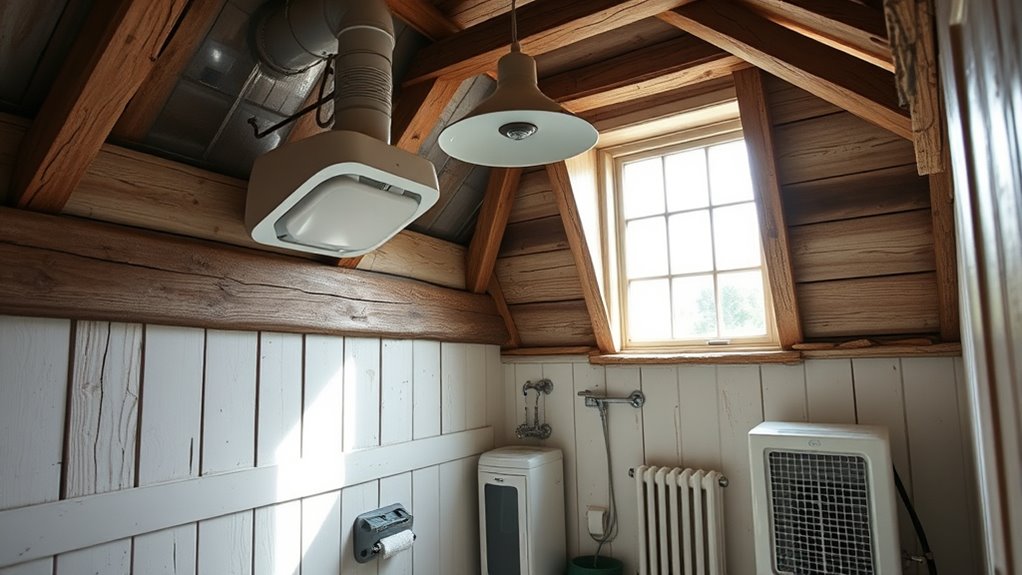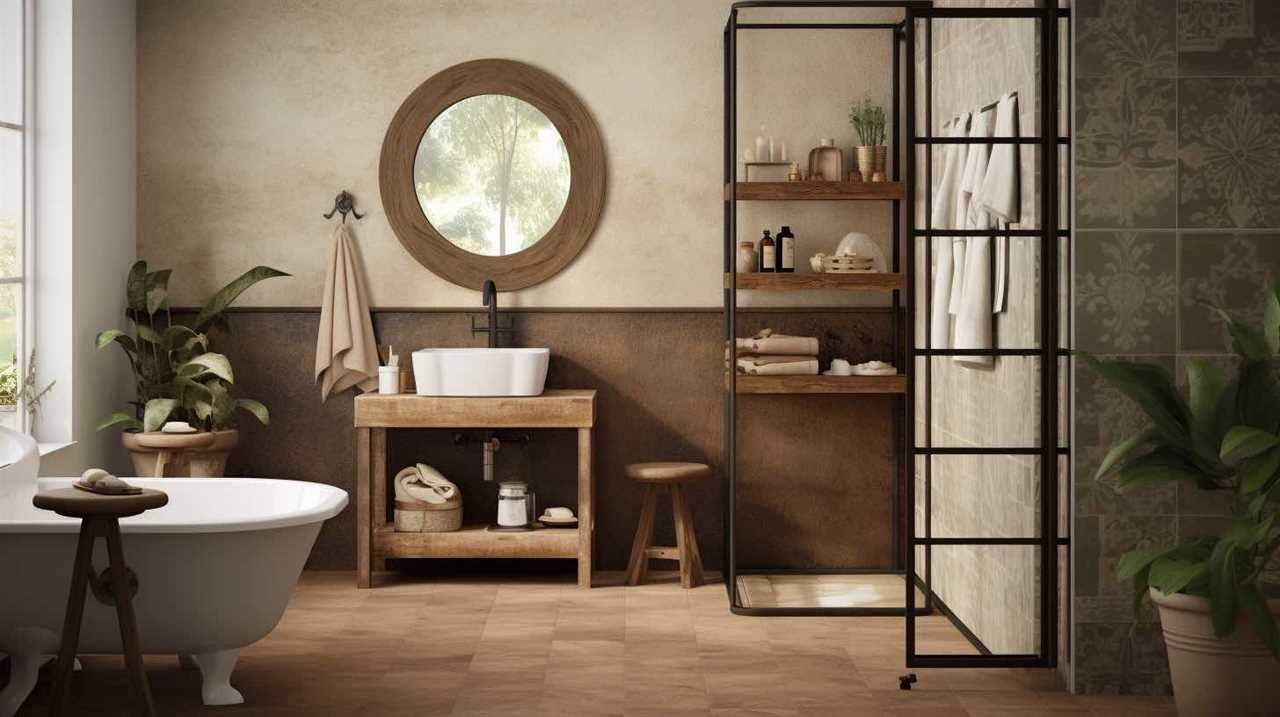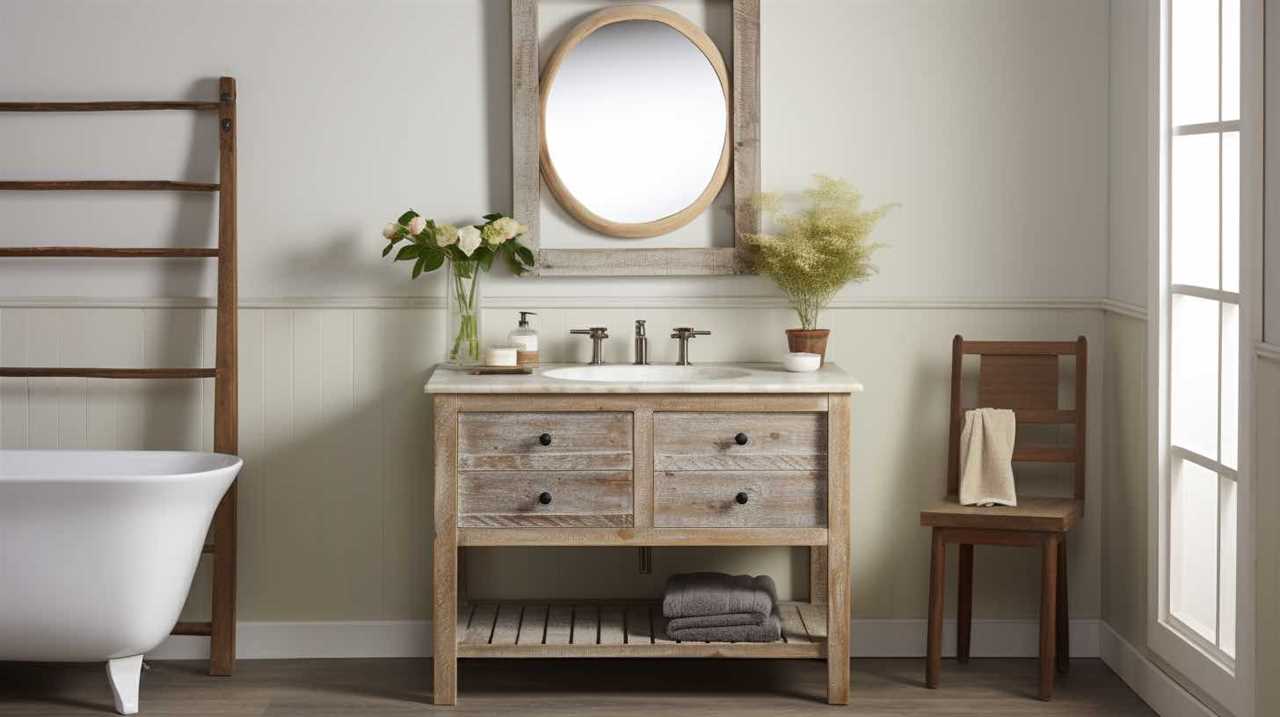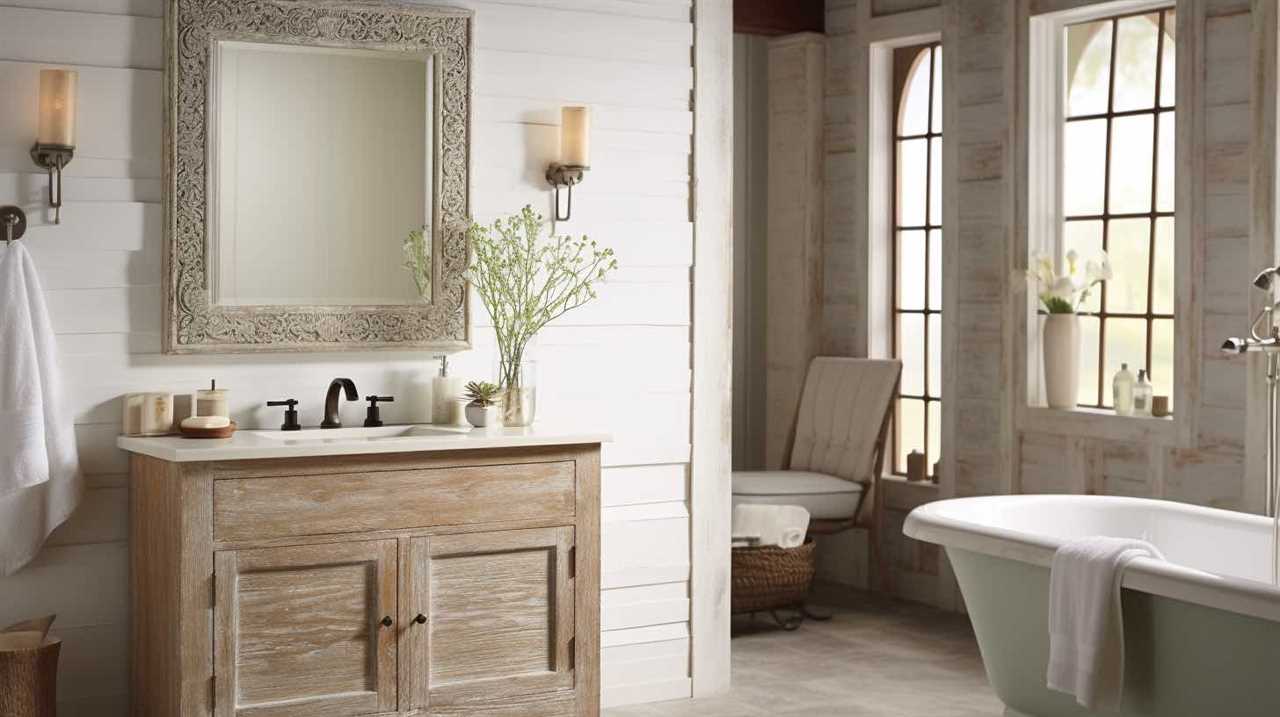To prevent moisture damage in your older farmhouse bathroom, upgrade your exhaust ventilation with a high-capacity fan vented outdoors, and make certain it’s properly sized for your space. Seal leaks around windows, doors, and fixtures to minimize drafts and moisture intrusion. Regularly inspect for leaks, replace old grout or caulking with mold-resistant materials, and wipe surfaces dry after use. Combining these strategies helps keep humidity in check and protects your bathroom from mold and damage—learn more to safeguard your space effectively.
Key Takeaways
- Upgrade to high-capacity, outdoor venting exhaust fans to effectively remove excess humidity.
- Seal leaks around windows, doors, and fixtures using mold-resistant materials to prevent moisture intrusion.
- Install humidity sensors or timers to automate ventilation during and after showers for consistent moisture control.
- Regularly inspect and replace old grout, caulking, and seals with mold-resistant products to prevent water seepage.
- Maintain good airflow, wipe down surfaces after use, and use moisture absorbers to keep bathroom areas dry.

Older farmhouse bathrooms are especially vulnerable to moisture damage due to their age and often outdated ventilation and sealing methods. If you want to protect your home’s integrity, it’s vital to address these issues head-on. One of the most effective steps you can take is implementing ventilation upgrades. Older bathrooms typically lack proper exhaust fans or have ones that no longer function efficiently. Upgrading to a modern, high-capacity exhaust fan helps remove excess humidity quickly, preventing moisture from lingering on walls, ceilings, and fixtures. It’s best to install a fan that’s appropriately sized for your bathroom’s square footage and ensure it’s vented outdoors, not into the attic or crawl space, which could lead to hidden mold growth.
Upgrade bathroom ventilation with a high-capacity exhaust fan vented outdoors to prevent moisture buildup and mold growth.
Beyond just adding a new fan, consider improving your bathroom’s overall airflow by sealing leaks around windows, doors, and fixtures. Proper sealing minimizes drafts and reduces the chances of moisture seeping into hidden corners, where mold can thrive undetected. When upgrading ventilation, also think about incorporating humidity sensors or timers that turn the fan on automatically when moisture levels rise. This proactive approach guarantees your bathroom remains dry after showers and baths, markedly reducing the chances of mold development.
Mold prevention strategies also include controlling moisture levels and maintaining a clean environment. Regularly inspecting your bathroom for leaks, especially around plumbing fixtures and seals, can catch problems early before they escalate. Keep surfaces dry by wiping down walls and mirrors after use, and consider using moisture-absorbing products in areas prone to dampness. Installing mold-resistant paint or sealants on walls and ceilings provides an extra layer of defense, making it harder for mold spores to settle and grow. Additionally, ensuring good air circulation can help reduce humidity levels more effectively, further protecting against mold growth.
Furthermore, attention to the bathroom’s overall sealing is vital. Old grout, caulking, and seals degrade over time, creating gaps that trap moisture. Replacing these with modern, mold-resistant materials helps keep water where it belongs—away from your walls and ceilings. When combined with effective ventilation upgrades and diligent mold prevention strategies, these measures drastically reduce your risk of moisture damage.
Frequently Asked Questions
How Often Should I Inspect My Farmhouse Bathroom for Moisture Issues?
You should inspect your farmhouse bathroom for moisture issues at least once a month. Focus on ventilation maintenance, ensuring exhaust fans and vents work properly, and check for signs of moisture buildup like mold or peeling paint. Regular moisture monitoring helps catch problems early, preventing damage. By staying vigilant, you keep your bathroom dry, healthy, and well-maintained, avoiding costly repairs down the line.
Can I Use DIY Methods to Fix Hidden Leaks Under the Bathroom Floor?
You can’t just sweep problems under the rug when it comes to hidden leaks. DIY fixes like inspecting for pipe insulation issues and shutting off the water supply can help, but don’t forget, some leaks hide behind walls or under floors. If you suspect a leak, consider using a moisture meter or calling a professional. Acting quickly prevents small issues from turning into big headaches later on.
What Are the Best Low-Cost Remedies for Improving Ventilation?
To improve ventilation without breaking the bank, consider exhaust fan upgrades that boost airflow and reduce humidity. Additionally, explore window venting options like installing a vent or crack to encourage natural air circulation. Keep vents clean and unobstructed for ideal performance. These low-cost remedies help control moisture, preventing damage and mold buildup, making your bathroom safer and more comfortable without expensive renovations.
How Do I Identify Early Signs of Mold and Mildew Growth?
Think of mold prevention as a detective game—you’re searching for clues like discolored spots, a musty smell, or fuzzy patches on walls and ceilings. Mildew inspection often reveals tiny, powdery or slimy growths in damp corners. Early signs include peeling paint or wallpaper, water stains, or a persistent odor. Spotting these signs early helps you take action before mold and mildew become bigger problems, maintaining a healthier bathroom environment.
Are There Specific Paints or Sealants Recommended for Old Bathroom Walls?
You should choose paint sealants specifically designed for bathrooms, as they provide a water-resistant barrier that protects your walls. Look for products with mold inhibitors to prevent mold and mildew growth over time. These paints are formulated to withstand high humidity and moisture, making them ideal for older farmhouse bathrooms. Applying such sealants guarantees your walls stay dry and mold-free, extending the life and beauty of your space.
Conclusion
By taking these simple steps, you can protect your farmhouse bathroom from costly moisture damage. Don’t let worries about existing damage or renovation costs hold you back—regular maintenance, proper ventilation, and moisture barriers make a big difference. Picture your bathroom staying dry, fresh, and beautiful for years to come. With a little effort now, you’ll prevent future problems and enjoy a cozy, worry-free space that’s both functional and charming.










